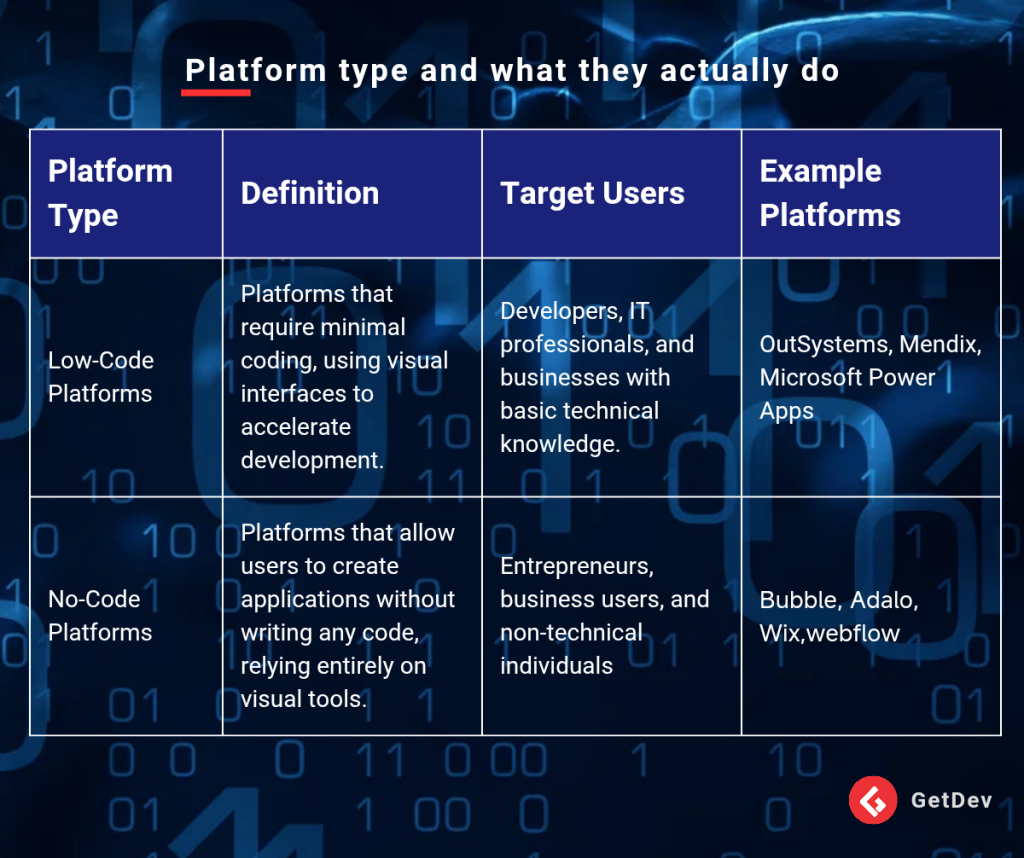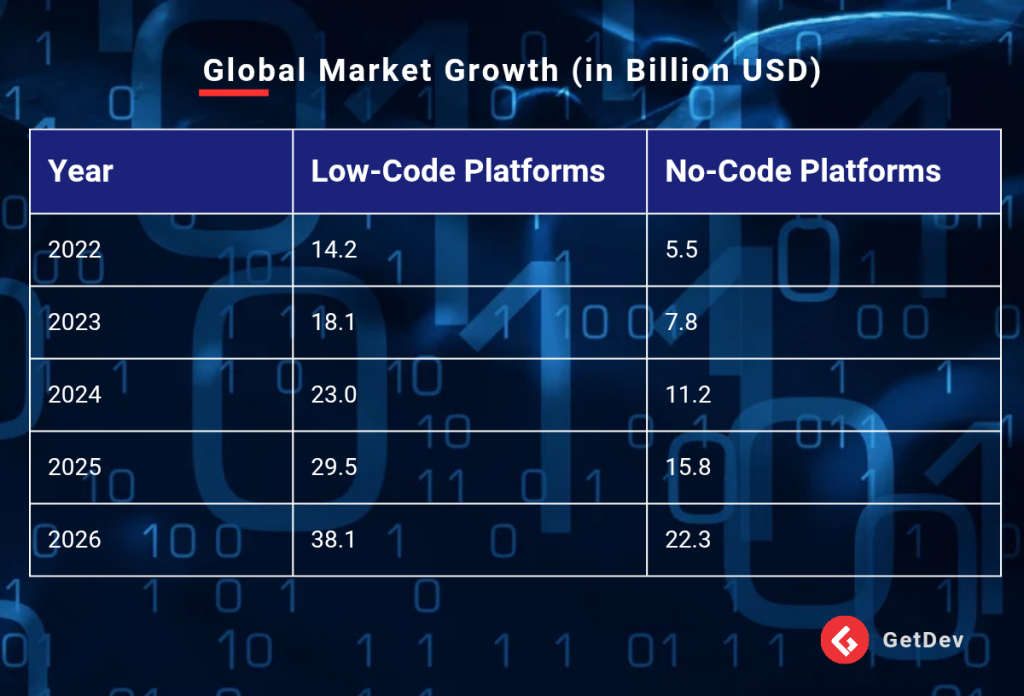
The tech industry is evolving rapidly, with low-code and no-code platforms emerging as major disruptors. These tools promise faster development, lower costs, and greater accessibility for non-technical users, enabling businesses to create applications without large development teams. But this raises an important question: Are developers at risk? As companies increasingly adopt these platforms to streamline operations, some argue that traditional coding is becoming obsolete. However, is the future of software development truly in the hands of non-technical users, or is this shift simply redefining the role of developers? In this article, we’ll examine the impact of these platforms, their limitations, and whether software engineers should be worried or optimistic about what lies ahead.
Imagine a CEO walking into a meeting, slamming their laptop on the table, and declaring, “We don’t need developers anymore! We just built our own app in a day without writing a single line of code!” The developers in the room exchange nervous glances. Is this the beginning of the end? Are they about to be replaced by non-technical users armed with drag-and-drop interfaces? The rise of low-code and no-code platforms has sparked debate in the tech industry. While these tools empower businesses to build software without deep programming knowledge, they also raise the question: Are developers at risk? Will these platforms replace software engineers, or are they simply another tool for developers? In this article, we’ll explore their impact, strengths, and limitations, and determine whether developers should be worried or excited.
What Are Low-Code and No-Code Platforms?
Before we dive into the risks (or lack thereof), let’s clarify what these platforms actually do.

Both categories aim to simplify software development, but they cater to different audiences. Low-code platforms provide a balance between coding and automation, making them ideal for developers who want to speed up application development while retaining customization options. No-code platforms, on the other hand, remove the need for coding entirely, making them accessible to non-technical users who want to build functional applications without technical expertise. At first glance, these platforms appear to be game-changers, making software development easier and more efficient. But here’s the real question: Will these tools make developers obsolete? Let’s investigate.
The Explosive Growth of Low-Code and No-Code Platforms
The rise of low-code and no-code platforms has been nothing short of meteoric. According to Gartner, by 2026, over 80% of software development will be done using low-code or no-code platforms, highlighting the rapidly growing shift in the way software is built and deployed. Let’s break down why these platforms are experiencing such rapid growth:

- Speed of Development
Traditional software development can take months or even years to complete, with complex coding, testing, and revisions involved. Low-code and no-code platforms drastically reduce this timeline, allowing for the creation of applications in a matter of weeks, days, or even hours, depending on the complexity of the solution. - Cost Efficiency
Hiring skilled developers can be expensive, especially for small businesses or startups. These platforms offer an affordable alternative by empowering non-technical employees to create and deploy solutions, cutting down on the need for costly specialized labor while maintaining high productivity and innovation. - Bridging the Developer Shortage
The world is facing a significant shortage of skilled software developers, which can slow down development cycles and limit opportunities for companies to scale. Low-code and no-code platforms help bridge this gap by enabling non-technical teams to contribute to the software development process, effectively expanding the pool of people who can work on tech projects without requiring deep coding expertise.
Growth Trends of Low-Code and No-Code Platforms
The rise of low-code and no-code platforms is not a temporary wave, it is a full-scale transformation in software development. Businesses of all sizes are increasingly adopting these platforms to speed up digital transformation, reduce reliance on traditional coding, and empower non-technical teams. The following chart shows the projected market growth for low-code and no-code platforms over the next few years:
Global Market Growth (in Billion USD)

These figures highlight a clear upward trajectory, proving that low-code and no-code platforms are becoming an integral part of modern software development. As organizations continue to prioritize agility and cost-effectiveness, the demand for these platforms will only increase.
But does this mean developers should start updating their résumés and looking for alternative careers? Not quite. While low-code and no-code tools are powerful, they are far from a replacement for skilled software engineers. Instead, they represent a shift in how development is done, one that requires adaptation rather than panic. Let’s explore why developers still hold a crucial place in this new era.
Are Developers at Risk?
Let’s address the elephant in the room: Are developers at risk of becoming obsolete due to the rise of low-code and no-code platforms? While these platforms are certainly transforming the landscape of software development, developers still play a crucial role. Here’s why developers shouldn’t worry:
1. Complex Applications Still Require Coding
While no-code tools are great for building simple applications, they fall short when it comes to creating advanced platforms like AI-driven solutions, enterprise software, or scalable cloud applications. Large-scale applications – those involving complex functionality, high user traffic, and intricate business logic still require skilled developers to handle backend logic, optimize performance, ensure security, and implement necessary integrations. These tools cannot replicate the level of customization and precision that experienced developers provide.
2. Security and Compliance Challenges
Enterprises that deal with sensitive data, such as healthcare or financial organizations, cannot fully rely on no-code tools due to security concerns. Developers are essential for ensuring that applications comply with strict industry regulations, including GDPR, HIPAA, and ISO standards, as they possess the knowledge to implement robust security measures and maintain compliance with legal requirements.
3. Customization Limitations
While no-code tools offer pre-built templates and drag-and-drop features, they often lack the flexibility needed for deep customization. Companies with specific or unique requirements, such as those needing specialized features or complex workflows, still need developers to write custom code and logic that no-code platforms simply can’t accommodate. Developers ensure that applications meet the exact needs of the business, which is something no-code solutions struggle to achieve on their own.
4. Integration with Other Systems
Businesses often rely on complex systems like ERP, CRM, and other enterprise software, and these systems typically require custom integrations. No-code tools may not support or adequately handle these types of integrations, which is where developers come in. Developers are needed to ensure that different technologies and systems work together seamlessly, creating a unified experience for users.
The Real Risk: Changing Job Roles

While developers are not at risk of being replaced, their roles are undoubtedly evolving. The shift towards low-code and no-code platforms means that software engineers will spend less time on repetitive coding tasks and more time on strategic problem-solving, automation, and optimization.
Instead of focusing on writing lines of code from scratch, developers will play a critical role in managing workflows, integrating third-party services, ensuring security, and customizing applications beyond what no-code tools can offer. The demand for technical expertise will not disappear; rather, it will shift towards higher-value tasks that require creativity, logic, and engineering knowledge.
Here’s a look at how the traditional responsibilities of developers are transforming:

The Future: Collaboration, Not Competition
Rather than replacing developers, low-code and no-code platforms are designed to augment their capabilities and enhance the software development process. Here’s why developers still have a crucial role to play:
1. Developers Will Lead the No-Code Revolution
While no-code and low-code tools make it easier for non-technical users to create applications, businesses still need technical guidance to ensure these tools are used effectively. Developers will take on the role of consultants, helping companies choose the right platforms based on their needs and ensuring smooth integration with existing systems. Their expertise will be vital in ensuring that these tools are implemented in a way that aligns with the company’s long-term goals and technical architecture.
2. Hybrid Development Will Become the Norm
In the future, businesses will use no-code platforms for rapid prototyping and building simple applications, while low-code tools will be employed to streamline the development of more complex workflows.Developers will play an integral role in refining, optimizing, and securing these applications. They will handle more intricate parts of the development process, ensuring that the solutions are scalable, efficient, and meet the high-quality standards necessary for enterprise-level applications. The collaboration between no-code, low-code, and traditional development will create a more dynamic and versatile software development landscape.
3. AI and Automation Will Work Alongside Developers
AI-driven low-code tools will increasingly take over repetitive and mundane tasks, such as creating basic code snippets, allowing developers to focus on high-level problem-solving and complex decision-making. Instead of spending time writing boilerplate code, developers will leverage AI to generate those parts of the code while dedicating their expertise to the architecture, innovation, and optimization of the overall system. This collaboration between developers and AI will enhance productivity and free up developers to tackle more challenging and creative aspects of the development process.
Conclusion
So, are developers at risk of becoming obsolete due to the rise of low-code and no-code platforms? Not at all, unless they refuse to adapt. The growing prevalence of these platforms is not a threat to developers; instead, it presents a significant opportunity. Rather than fearing these tools or viewing them as a challenge, developers should embrace them as a way to enhance their efficiency, foster innovation, and increase their overall value to the business. Think of it like this: Calculators didn’t replace mathematicians, and Photoshop didn’t eliminate graphic designers. Similarly, low-code and no-code platforms won’t render developers obsolete; instead, they will transform the way software is built, allowing developers to focus on more complex tasks while leveraging these tools to streamline the development process.
In the end, the future will be shaped by those who are willing to embrace change and adapt to new technologies. So, the real question is: Will you choose to adapt and thrive, or will you resist and risk being left behind? The choice is in your hands.